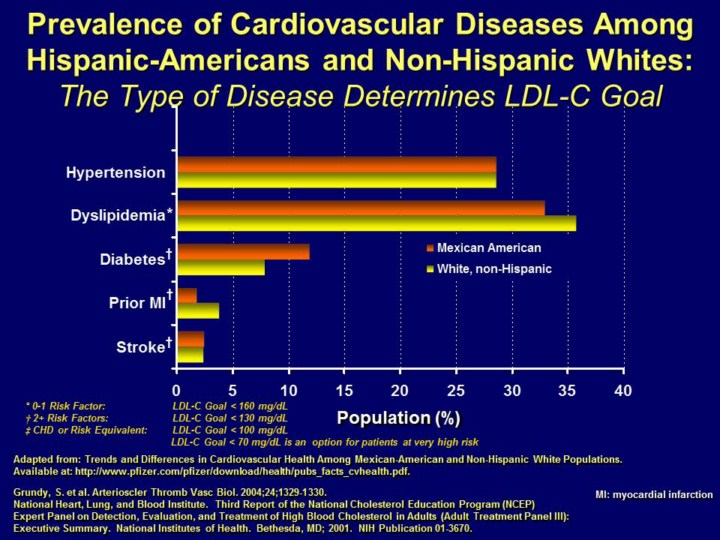| front |1 |2 |3 |4 |5 |6 |7 |8 |9 |10 |11 |12 |13 |14 |15 |16 |17 |18 |19 |20 |21 |22 |23 |24 |25 |26 |27 |28 |29 |30 |31 |32 |33 |34 |35 |36 |37 |38 |39 |40 |41 |42 |43 |44 |45 |46 |47 |48 |49 |50 |51 |52 |53 |54 |55 |review |
 |
The prevalence of cardiovascular diseases among Hispanic and non-Hispanic whites are displayed on the current slide.
The age-adjusted prevalence rates of hypertension, stroke, and dyslipidemia are similar in both populations. However, the prevalence of diabetes remains higher among Mexican-Americans than among non-Hispanic whites.1
ATP III-defined LDL-C goals are dependent on the presence or absence of coronary heart disease or the number of CHD risk factors. As the number of CHD risk factors increases the LDL-C goals decrease.1
References: 1. Trends and Differences in Cardiovascular Health Among Mexican-American and Non-Hispanic White Populations. Available at: http://www.pfizer.com/pfizer/download/health/pubs_facts_cvhealth.pdf. 2. National Heart, Lung, and Blood Institute. Third Report of the National Cholesterol Education Program (NCEP)Expert Panel on Detection, Evaluation, and Treatment of High Blood Cholesterol in Adults (Adult Treatment Panel III): Executive Summary. National Institutes of Health. Bethesda, MD; 2001. NIH Publication 01-3670. 3. Grundy, Scott et al. Education Program Adult Treatment Panel III Guidelines A Summary of Implications of Recent Clinical Trials for the National Cholesterol. Arterioscler. Thromb. Vasc. Biol. 2004;24;1329-1330.
|